

It is quite clear that a text such as this has been written in such a way that black presence is erased while white presence is magnified. What is striking in this representation of a typical upper middle-class American family is the absence of acknowledgement of the existence of black life in America, or rather, the refusal to depict black people when representing the American society. Those who did not match this description felt excluded from the society as they were implicitly told that something about them did not correspond to the definition of an American, be it the size of their house, the number of pets they had, or simply their names. One must note that this primer was commonly found in the public schools in the United States of America at that time: in other words, being taught such an example from their early years, children in the United States insidiously learnt what “the norm” was for an American. (Morrison 1970: 1)ĦObviously, this primer corresponds to a certain type of family–more precisely, a white American family, living in a pleasant house and leading a happy life–, and had no intention of depicting every family that could be found in America in fact, many could not identify with this description. Do you want to play with Jane? See the dog run. Father, will you play with Jane? Father is smiling. Mother, will you play with Jane? Mother laughs. Mother, Father, Dick, and Jane live in the green-and-white house. The origins of silenceĥThe “Dick and Jane” primer, with which the novel opens, portrays a typical American family of the 1940s: A close study of the narrative devices used in the novel, however, will show that Toni Morrison’s very act of writing is a way to claim the voice(s) stolen by white domination and give it/them back to the ones who have been silenced and empower them. In a desperate attempt to find a voice in order to survive, the characters are led to re-create the oppressive system they suffer from in their own community by mistreating their weakest members, such as Pecola Breedlove. Silence is inherent in the black community: an analysis of its origins will first put highlight the fact that the absence of voice the characters are trapped in has been inherited from their ancestors’ past condition as slaves. This normalized racism leads to what Toni Morrison calls “racial self-loathing” in the Afterword of her novel (Morrison 1970: 167), as most of them are unable to stand up to the dominant group and are left frustrated, with an extremely damaged self-esteem.ĤThis article will focus on the black characters’ powerlessness against racism that makes them voiceless.


The novel follows the story of a little black girl, Pecola Breedlove who fails to find her place in the white American society she lives in: being by no means protected by her family and finding no support from any other member of her community, she is left to herself in a world where her very existence is rejected.ĢUsing the different points of view of the characters, the writer Toni Morrison throws light on how the omnipresence of racism has led coloured, and more particularly black people, to accept their inferior status: this paper aims at explaining how the black characters’ silencing is the result of the whites’ constant oppression, past and present, which has led them to internalize the idea of white superiority.ģThe black characters in the novel are shown struggling, and sometimes incapable to fight against racism which has become part of their daily lives, while desperately trying to find a way to survive in a society that systematically rejects them because of the colour of their skin.

1Published in 1970, The Bluest Eye focuses on the racial tensions in the American society in the 1940s.


 0 kommentar(er)
0 kommentar(er)
